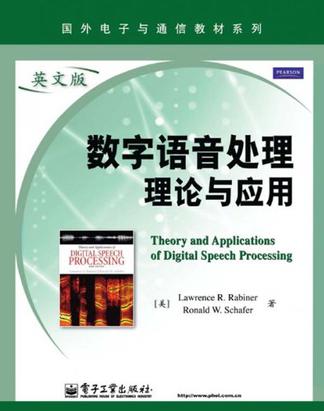数字语音处理理论与应用

内容简介:
《数字语音处理理论与应用(英文版)》是作者继1978年版经典教材《语音信号数字处理》之后的又一著作,全书除有简练精辟的基础知识介绍外,系统介绍了近30年来语音信号处理的新理论、新方法和在应用上的新进展。全书共14章,分四部分:第一部分介绍语音信号处理基础知识,主要包括数字信号处理基础、语音产生机理、(人的)听觉和听感知机理和声道中的声传播原理;第二部分介绍语音信号的时频域表示和分析;第三部分介绍语音参数估计算法;第四部分介绍语音信号处理的应用,主要包括语音编码、语音和音频信号的频域编码、语音合成、语音识别和自然语言理解。
目录:
preface chapter 1 introduction to digital speechprocessing 1.1 the speechsignal 1.2 the speechstack 1.3 applicationsof digital speechprocessing 1.4 commentonthe references 1.5 summary chapter 2 reviewof fundamentalsof digitalsignalprocessing 2.1 introduction 2.2 discrete-time signals and systems 2.3 transform representation of signals and systems 2.4 fundamentalsof digitalfilters 2.5 sampling 2.6 summary problems chapter 3 fundamentalsof human speechproduction 3.1 introduction 3.2 the processofspeechproduction 3.3 short-timefourierrepresentationofspeech .3.4 acousticphonetics 3.5 distinctivefeaturesof thephonemesof american english 3.6 summary problems chapter 4 hearing,auditory models,and speechperception 4.1 introduction 4.2 the speechchain 4.3 anatomy andfunctionof theear 4.4 the perception of sound 4.5 auditory models 4.6 human speechperceptionexperiments 4.7 measurementofspeechqualityand intelligibility 4.8 summary problems chapter 5 sound propagationinthe humanvocaltract 5.1 the acoustictheoryofspeechproduction 5.2 losslesstube models 5.3 digital models forsampled speechsignals 5.4 summary problems chapter 6 time-domainmethods for speechprocessing 6.1 introduction 6.2 short-timeanalysisofspeech 6.3 short-timeenergyand short-timemagnitude 6.4 short-timezero-crossing rate 6.5 the short-timeautocorrelation function 6.6 the modied short-timeautocorrelation function 6.7 the short-timeaverage magnitude differencefunction 6.8 summary problems chapter 7 frequency-domainrepresentations 7.1 introduction 7.2 discrete-timefourieranalysis 7.3 short-timefourieranalysis 7.4 spectrographicdisplays 7.5 overlapaddition methodof synthesis 7.6 filter bank summationmethodof synthesis 7.7 time-decimatedfilter banks 7.8 two-channelfilter banks 7.9 implementationof thefbs method usingthe fft 7.10 olarevisited 7.11 modicationsof thestft 7.12 summary problems chapter 8 thecepstrumand homomorphic speechprocessing 8.1 introduction 8.2 homomorphicsystems forconvolution 8.3 homomorphicanalysisofthe speechmodel 8.4 computingthe short-timecepstrumand complexcepstrum of speech 8.5 homomorphicfilteringofnatural speech 8.6 cepstrumanalysisofall-pole models 8.7 cepstrumdistancemeasures 8.8 summary problems chapter 9 linear predictive analysisof speechsignals 9.1 introduction 9.2 basic principles of linear predictive analysis 9.3 computationofthe gainfor themodel 9.4 frequencydomaininterpretationsof linear predictiveanalysis 9.5 solutionofthe lpcequations 9.6 the prediction errorsignal 9.7 somepropertiesofthe lpcpolynomial a(z) 9.8 relationoflinear predictive analysisto losslesstube models 9.9 alternative representationsof thelpparameters 9.10 summary 560problems chapter 10 algorithms for estimating speechparameters 10.1 introduction 10.2 mediansmoothing and speechprocessing 10.3 speech-background/silencediscrimination 10.4 abayesianapproach tovoiced/unvoiced/silence detection 10.5 pitch period estimation(pitch detection) 10.6 formant estimation 10.7 summary 645problems chapter 11 digitalcodingof speechsignals 11.1 introduction 11.2 sampling speechsignals 11.3 astatisticalmodelfor speech 11.4 instantaneous quantization 11.5 adaptivequantization 11.6 quantizingofspeechmodelparameters 11.7 generaltheoryof differentialquantization 11.8 delta modulation 11.9 differentialpcm (dpcm) 11.10 enhancements foradpcm coders 11.11 analysis-by-synthesis speechcoders 11.12 open-loop speechcoders 11.13 applicationsof speechcoders 11.14 summary 819problems chapter 12 frequency-domaincodingof speechandaudio 12.1 introduction 12.2 historicalperspective 12.3 subband coding 12.4 adaptivetransform coding 12.5 aperception modelforaudiocoding 12.6 mpeg-1audiocoding standard 12.7 otheraudiocoding standards 12.8 summary 894problems chapter 13 text-to-speechsynthesis methods 13.1 introduction 13.2 text analysis 13.3 evolutionof speechsynthesis methods 13.4 early speechsynthesis approaches 13.5 unitselection methods 13.6 tts future needs 13.7 visual tts 13.8summary 947problems chapter 14 automatic speechrecognition andnatural language understanding 14.1 introduction 14.2 basic asrformulation 14.3 overall speechrecognition process 14.4 buildinga speechrecognition system 14.5 the decisionprocessesinasr 14.6 step3:the search problem 14.7 simpleasr system: isolateddigit recognition 14.8 performance evaluationof speechrecognizers 14.9 spokenlanguage understanding 14.10 dialog managementand spokenlanguage generation 14.11 user interfaces 14.12 multimodaluserinterfaces 14.13 summary 984problems appendices a speechandaudioprocessing demonstrations b solutionoffrequency-domaindifferentialequations bibliography index




评论